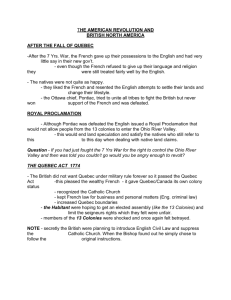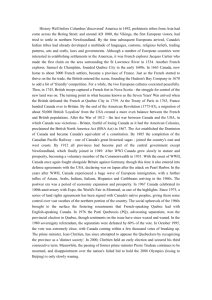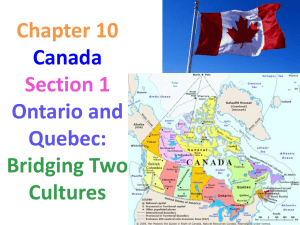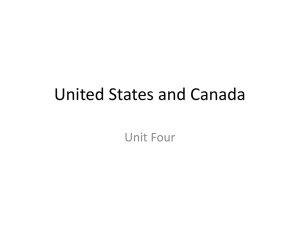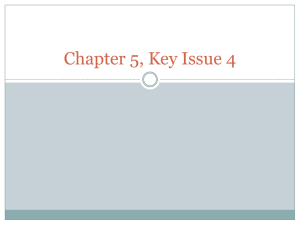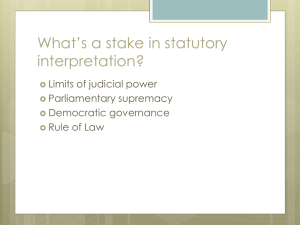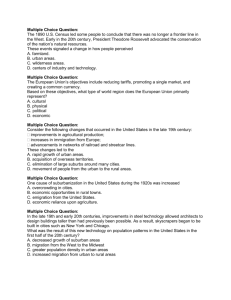Report for Executive Committee November 4
advertisement
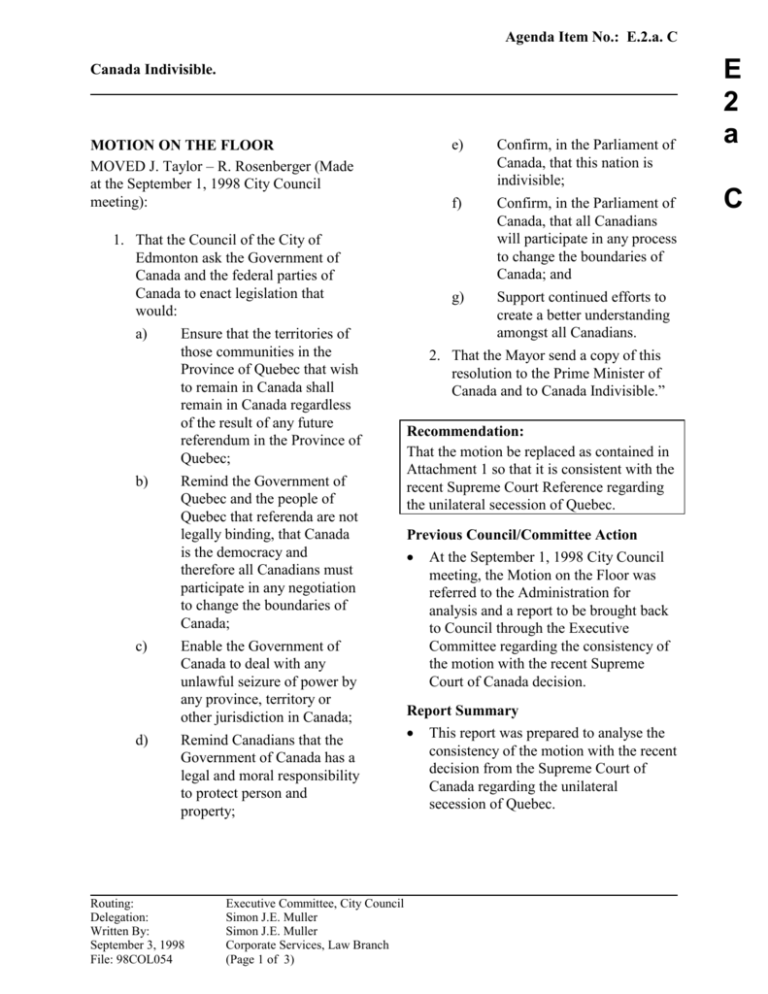
Agenda Item No.: E.2.a. C Canada Indivisible. MOTION ON THE FLOOR MOVED J. Taylor – R. Rosenberger (Made at the September 1, 1998 City Council meeting): 1. That the Council of the City of Edmonton ask the Government of Canada and the federal parties of Canada to enact legislation that would: a) b) c) d) Ensure that the territories of those communities in the Province of Quebec that wish to remain in Canada shall remain in Canada regardless of the result of any future referendum in the Province of Quebec; Remind the Government of Quebec and the people of Quebec that referenda are not legally binding, that Canada is the democracy and therefore all Canadians must participate in any negotiation to change the boundaries of Canada; Enable the Government of Canada to deal with any unlawful seizure of power by any province, territory or other jurisdiction in Canada; Remind Canadians that the Government of Canada has a legal and moral responsibility to protect person and property; Routing: Delegation: Written By: September 3, 1998 File: 98COL054 Executive Committee, City Council Simon J.E. Muller Simon J.E. Muller Corporate Services, Law Branch (Page 1 of 3) e) Confirm, in the Parliament of Canada, that this nation is indivisible; f) Confirm, in the Parliament of Canada, that all Canadians will participate in any process to change the boundaries of Canada; and g) Support continued efforts to create a better understanding amongst all Canadians. 2. That the Mayor send a copy of this resolution to the Prime Minister of Canada and to Canada Indivisible.” Recommendation: That the motion be replaced as contained in Attachment 1 so that it is consistent with the recent Supreme Court Reference regarding the unilateral secession of Quebec. Previous Council/Committee Action At the September 1, 1998 City Council meeting, the Motion on the Floor was referred to the Administration for analysis and a report to be brought back to Council through the Executive Committee regarding the consistency of the motion with the recent Supreme Court of Canada decision. Report Summary This report was prepared to analyse the consistency of the motion with the recent decision from the Supreme Court of Canada regarding the unilateral secession of Quebec. E 2 a C Canada Indivisible. Report On August 20, 1998 the Supreme Court of Canada issued its decision in Reference Re: Secession of Quebec. The decision addressed the issue of whether a unilateral declaration of secession by Quebec was legal. It also addressed the effect of a referendum in Quebec in which a clear majority voted in favour of secession. The decision of the Supreme Court of Canada conflicts with some of the wording of the proposed motion. Subsection (a) of the motion asks the Government of Canada to legislate in a manner so as to ensure that communities within Quebec wishing to remain in Canada could do so regardless of the result of any referendum in the Province of Quebec. The Supreme Court has said that “a clear expression of the desire to pursue secession by the population of a Province would give rise to a reciprocal obligation on all parties of confederation to negotiate constitutional changes.” These negotiations would have to be conducted in accordance with underlying constitutional principles and in good faith. It is probable that any legislation which dictates minimum terms for the negotiation of Quebec’s secession would be in bad faith and contravene the constitutional duty of the Federal Government to negotiate secession honourably with the Government of Quebec. Subsection (b) suggests that referenda are not binding and all Canadians must participate in any negotiations to change (Page 2 of 3) the boundaries of Canada. However, a successful referendum on secession will be binding. The Supreme Court held that all parties to confederation would be obligated to negotiate constitutional changes in the face of a referendum result favouring secession. The Court said that a clear majority of Quebecers voting in favour of secession on a clearly worded question would give rise to a right of the Government of Quebec to pursue secession. Therefore, a referendum result of this type would legitimize the constitutional efforts of Quebec, and oblige the rest of Canada to negotiate so as to give expression to the desires of the majority of the people of Quebec. Subsection (c) of the motion purports to enable the Government of Canada to deal with “any unlawful seizure of power by Quebec.” The Supreme Court held that “the rights of other provinces and the Federal Government cannot deny the right of the Government of Quebec to pursue secession should a clear majority of the people of Quebec choose that goal as long as in doing so Quebec respects the rights of others.” It is possible that, should the rest of Canada not negotiate in good faith with Quebec, this may give Quebec a right to unilaterally secede and legitimately seize power over the Province. However, the Court chose not to speculate as what would transpire in such circumstances. The underlying danger of recommendation (c) is that it is a tacit endorsement of the use of force by the Government of Canada should Canada Indivisible. Quebec unilaterally declare independence. Subsection (d) is consistent with the Court’s decision. Subsection (e) of the motion is inaccurate. The Supreme Court has held that the nation is divisible if it is the clear expression of a clear majority of the population of a Province to secede. However, the Court did comment that “nobody seriously suggests that our national existence, seamless in so many aspects, could be effortlessly separated along what are now the provincial boundaries of Quebec.” Besides commenting on the difficulties of separation, the Court seems to suggest that Provincial boundaries are negotiable. This leaves open the possibility of the partition of Quebec. Subsection (f) asks the Federal Government to confirm that all Canadians would participate in changing the boundaries of Canada. This is inconsistent with subsection (e) which says that Canada is indivisible. Subsection (g) is not contentious. By supporting this motion Council would be asking the Government of Canada to pass legislation that is in direct conflict with the Supreme Court of Canada decision. While there is nothing inherently illegal about Council asking the Federal Government to adopt the recommendation in the motion, the effectiveness of the messages conveyed by the motion may be diminished. The motion could be reworded so as to be consistent with the Supreme Court Reference. A sample of a reworded motion is attached. Justification of Recommendation The motion as worded is inconsistent with the Supreme Court of Canada’s decision in Reference Re: Secession of Quebec. An inaccurate motion may be less effective than an accurate motion. Background Information Attached 1. Proposed Wording of Canada Indivisible Motion so as to be Consistent with the Supreme Court of Canada’s Decision in Reference Re: Secession of Quebec. Background Information Available on Request 1. Copy of the decision of the Supreme Court of Canada in Reference Re: Secession of Quebec dated August 20, 1998. (Page 3 of 3) Attachment 1 Proposed Wording of Canada Indivisible Motion so as to be Consistent with the Supreme Court of Canada’s Decision in Reference Re: Secession of Quebec I move that: 1. The Council of the City of Edmonton ask the Government of Canada and the Federal parties of Canada to enact legislation that would: a. Require the Government of Canada to do its utmost to negotiate with the Province of Quebec so that any community wishing to remain in Canada could do so even if a future referendum in the Province of Quebec clearly supported secession. b. Recognize that the interests of all Canadians must be presented and considered in any negotiation to change the boundaries of Canada should a clear majority of Quebecers vote in favour of secession when presented with a clear referendum question. c. Enable the Government of Canada to prevent any unlawful seizure of power by any province in Canada by negotiating in good faith and in accordance with constitutional and democratic principles should there be a clear expression by a clear majority of the population in a province of a desire to secede. d. Reinforce that the Government of Canada has a legal and moral responsibility to protect persons and property while operating within a constitutional and democratic framework. e. Confirm that any division of Canada could only be affected by arduous and lengthy negotiations between all interested parties that recognize the rights of the minority, democratic principles, the rule of law and the Constitution. f. Confirm that the voices and interests of all Canadians must be heard and represented in any process to change the boundaries of Canada. g. Support continued efforts to create a better understanding amongst all Canadians. Attachment 1 - Page 1 of Error! Bookmark not defined.

